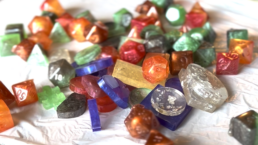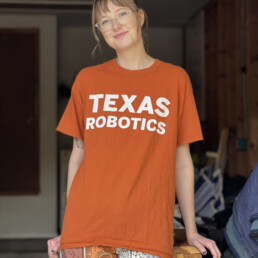
An Essay By Christina Petlowany
Read by the author, Christina Petlowany
My classmates were certain we needed to use steel. We were designing a wheelchair for a college engineering course, and they felt only steel would be strong enough for the handheld levers that would allow the user to propel the chair with a rowing motion. I wasn’t so sure. Based on my experience making sculptures with soda cans and creating jewelry with wire, I believed steel would be too heavy and aluminum would be a better option. But the student who most strongly advocated for steel worked at a bike shop; surely I didn’t know better, having used metal only for crafts. A few days later, when the hefty, overbuilt steel arm kept flopping down, I felt validated. I was right — and I wished I had shown more steely resolve in defending my position.
I was a crafty kid. Not crafty like a fox, but crafty to the point that my parents would come home braced for whatever artistic
explosion I had unleashed that day — origami, painting, clay sculpting, sewing stuffed animals and clothes, and more. But when I enrolled in engineering in college, I put these pursuits aside. Not only was I stretched for time, but I didn’t think they were relevant to my academic work — and I hesitated to highlight my feminine
crafting interests in the male-dominated engineering environment where I already felt like an outsider. I told myself that engineering adequately fed my creative side and I didn’t need the hobby.
The wheelchair project was a hint that my crafting might be important and relevant, but for the next few years, I continued to avoid bringing it up in professional spaces. When I was interviewing for engineering jobs after finishing my master’s degree and was asked whether I tinkered in my spare time, for example, I was sure the panelists wouldn’t care about my elaborate homemade holiday cards, even though they featured lever action and moving parts. Instead, I muttered about wanting to do more 3D printing. The company extended an offer, so I felt my assumption was confirmed.
My attitude didn’t change when I went on to pursue a Ph.D. — until early in the pandemic, when I felt restless and turned to crafting as an outlet. I was making a set of Dungeons & Dragons dice, shimmery blue and purple swirled with gold flakes, as a gift for a friend. While pipetting the liquid resin into the silicone mold, I made an off-hand joke to my partner that I was injection molding
— a standard engineering manufacturing process. I suddenly realized that although resin art is not injection molding in the technical sense, it shares the spirit and probably some skills. Maybe my crafting was something I should embrace rather than hide.

Part of making Dungeons & Dragons dice for a friend turned out to be very similar to injection molding, a common engineering manufacturing process.
Soon I was seeing more examples of connections between engineering and craft that I had previously overlooked. When working on the wheelchair project, I put my sewing skills to use creating cushioned grips for the handles. The engineering design kitchen
where my undergrad classmates and I tested our ideas was stocked with inexpensive tools including felt, pipe cleaners, and popsicle sticks — materials that would not be out of place in a craft bin. I saw how crafting taught me to persevere when my product didn’t match my initial vision and to consider the failed creation a learning and prototyping experience, just as an engineer must.
Since then, I’ve built crafting back into my free time. I’ve also stopped hiding it from my colleagues. I mentioned my dice-making escapades at a robotics conference and broached in a team meeting how we could gain inspiration from an interactive art experience I had recently visited. The responses were consistently positive and constructive — not dismissive or insulting, as I used to fear.
I’ve grown from a girl who created a makeshift vulpine friend by attaching legs to a stuffed sock and coloring it with red Sharpie to an engineer with valuable skills from my first passion. Perhaps I am crafty like a fox. I am also crafty like an engineer.

This essay was originally written for and published in Science Magazine.
Christina Petlowany is a graduate research assistant in the nuclear and applied robotics group in the Walker Department of Mechanical Engineering. Her current research focuses on user situational awareness for multi-robot systems. Learn more at https://cpetlowany.github.io/.